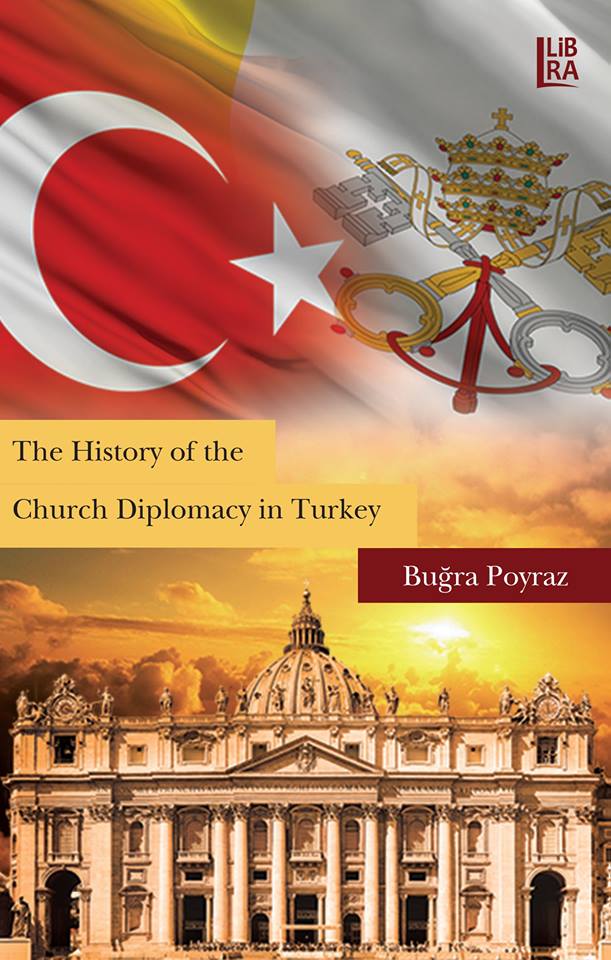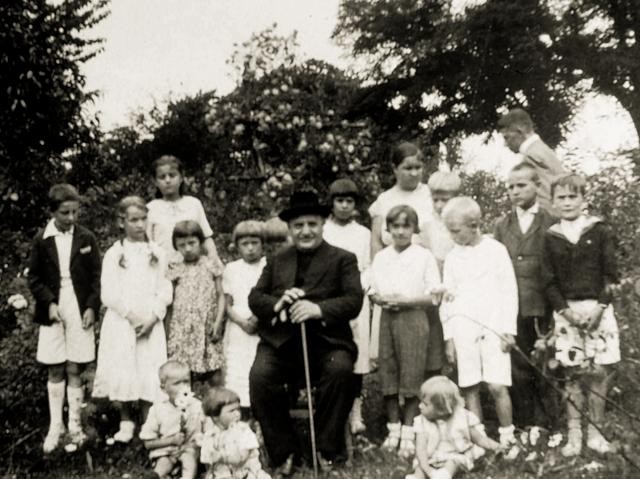
The Interviewees
Herve Georgelin | Pelin Böke | Alex Baltazzi | Axel Corlu | Philip Mansel | Antony Wynn | Fortunato Maresia | Vjeran Kursar | Christine Lindner | Frank Castiglione | Clifford Endres | Zeynep Cebeci Suvari | Sadık Uşaklıgil | İlhan Pınar | Ümit Eser | Bugra Poyraz | Oğuz Aydemir

Interview with Bugra Poyraz, October 2016
1- What was the original impetus that led you on the path to study the Catholic heritage of Turkey?
I felt closeness to the Catholic faith from a very young age, when I was in Izmir and attended for a few years theological and philosophical courses in Italy. After my return to Turkey in 2004, I started to work in the translation field and took editorial tasks for my local church in Izmir and also on behalf of the Catholic Bishops’ Conference of Turkey which is the highest Catholic authority of the country.
I have worked as a translator of His Exc. Mgr. Luigi Padovese, the previous Bishop – Apostolic Vicar of Anatolia from 2005 until June 2010 when he was murdered.
I am the editor-in-chief of the unique magazine for the Turkish speaking Catholics, called “Marana Tha” since 2009. I have collaborated with many researchers, including Rinaldo Marmara as translator, editor and had a long publishing involvement. During all these publishing activities, I felt there was a lack of an academic approach and methodology. This is why; three years ago I applied to the Master’s program in History at the Istanbul Bilgi University and got my Master’s Degree in History last year with a thesis entitled “The End of the Religious Protectorate of France for Ottoman Catholics and the Start of the Diplomatic Relations with the Holy See”.
2- You are currently an archivist and researcher at the Apostolic Vicariate of Istanbul and can you tell us what your day usually entails there? How extensive are the archives there?
I am currently working simultaneously in the secretariat and in the parish archives, helping to facilitate the communication of the religious body with the local Turkish authorities, while editing my PhD thesis with the title of “The Assyrian-Chaldeans of the Eastern Turkey. Geopolitics of the region and the migration to France in the twentieth century” under the supervision of Prof. Nora Seni at the Paris 8 University.
This is a very busy office where we prepare the celebrations of the Holy Spirit Cathedral, which is the centre of the Latin Catholic Community of Istanbul and have also services and activities for the refugees.
We can divide into two classifications the Church archives of Istanbul. In each parish, we have the baptism, marriage and funeral registers. In the central archive of the Apostolic Vicariate you can find documents of the single Catholic institutions and the correspondences of the bishops; but I must admit that each congregation (religious order) has its own archive. Many of the old documents are carried to the centres of the religious orders in Paris and in Rome.
The most important archives on the Catholic heritage of Turkey are found in the two sectors of the Vatican Secret Archives and Propaganda Fide Archives in Rome. There is a growing interest to the Vatican Secret Archives of the Turkish historians and researchers, also thanks to the oeuvres of Rinaldo Marmara. However, few researchers can have access to these archives. Not because of the difficulty of accessing to the archival folds, but because knowledge of French, Italian and Latin is a must.
Of course, when we say “Catholic” we don’t only mean the Latin Catholics. In Turkey there are many Oriental Catholic Churches like the Armenian Catholic Church, Syriac Catholic Church, Chaldean Catholic Church; and there are still Maronite Catholic and Greek Catholic (Melkites) families even without a resident priest; and also a Bulgarian Catholic Church existed in the past. All these churches have different archives in Turkey and also at their relative Patriarchates.
3- You have recently published a book, ‘The History of the Church Diplomacy in Turkey’; can you tell us which sources you consulted and what drove you to write this book?
In fact, this is my Master thesis in history which I defended last year at Istanbul Bilgi University with the title: “The End of the Religious Protectorate of France for Ottoman Catholics and the Start of the Diplomatic Relations with the Holy See”. I used mostly the documents from the Vatican Secret Archives which have been collected by Rinaldo Marmara and published bilingually with my translation into Turkish by the Bahçeşehir University in 2012. The title of this book was “Secondo Documenti dell’Archivio Segreto Vaticano - Verso Le Relazioni Tra La Santa Sede e La Turchia (Towards the Relations between the Holy See and Turkey – According to the Documents of the Vatican Secret Archives). These documents are the base of my research.
I chose this subject for my thesis, seeing the lack of such a study and sources, especially in English.
First of all, I have observed that the capitulations given by the Ottoman Empire first to France (in 1536) then to the other European powers from the point of view of religious rights. The birth and the function of the religious protectorate of France in the Ottoman territories; the claim of France for representing and protecting all the Christians in the Orient and the Sublime Porte’s limiting this protectorate of France to just Catholics; the tension between the anti-clerical Third French Republic and the Holy See and the effects of this tension on the French Ambassadors and Papal Delegates in front of the Sublime Porte and on the Catholics living in the Ottoman territories; the arrival and the activities of Mgr. Angelo Giuseppe Roncalli (Pope John XXIII) and the start of the diplomatic relations between the Holy See and Turkey are covered in my research.
4- How far back do the relations between the Vatican and Turkey / Ottoman Empire go?
The relations between the Catholics and the Ottoman Empire go back to the 15th century. When Mehmet II conquered the city of Constantinople, the Genovese and Venetian merchants who were resident in Galata continued to reside there thanks to Mehmet II’s Galata Ahitnamesi (the Treaty of Galata) which defined the rights and permission to remain of the Catholics in the Ottoman territories for the first time.
Charles A. Frazee’s book entitled “Catholics and Sultans – The Church and the Ottoman Empire 1453-1923” is a very nice and complete work to answer your question. In my research, I emphasized mostly the last quarter of 19th century, the period of Sultan Abdulhamid II and the relations during the Turkish republic until 1960.
5- In Ottoman times France was the ‘protector’ nation of Catholics. What was the meaning of this protection?
The Catholic protectorate of France in the Ottoman Empire which has been exercised for nearly four centuries, from 1536 until 1923, rendered immense services to the cause of Catholic religion. The French protectorate in the Ottoman Empire was the exclusive right of France that had to defend the Catholic Church in this country, a right that came with some honorary prerogatives.
The right of France of protecting the interests of the Catholic Church in the East was based primarily on the capitulations obtained from the Ottoman Administration. Thus, France, under the capitulations, extended its protection to all Catholic lay or religious people of Latin rite in the Ottoman Empire, of whatever nationality they had, individually or collectively, and their pious foundations, which belonged to Latin Catholics and to the Eastern Catholics of the Empire.
6- Did the tension between France and the Holy See affect the situation of the Catholic Church in the Ottoman Empire?
As a result of the hostility of the Third French Republic which endured from 1870 to 1940, many religious orders were disbanded in France and few orders could survive because of this governmental pressure. A diplomatic crisis broke out between the Holy See and France. The French ambassador to Rome was recalled and the papal nuncio to France was expelled. This crisis also affected the strength of France in Orient, which was the Protector of Latins and in a wide coverage, all the Catholic subjects. France lost the right of protection of Ottoman Catholics through the abolishment of the capitulations in 1923 by the Treaty of Lausanne. At the same time, during the sultanate of Abdulhamid II, the role of the apostolic delegate (representative of Pope before the diplomatic relations started) was enhanced in front of the Sublime Porte and during the pontificate of Pope John XXIII in 1960, the diplomatic relations between the Holy See and Turkey started by the appointment of a Turkish Ambassador to Vatican and an Apostolic Nuncio to Ankara.
7- In your opinion what is the biggest challenge to the Catholic community in present day Turkey?
The Latin Catholic Church in Turkey lacks legal definition and this is the biggest problem of this community today. The “Catholic” word means “universal”, however, among all the Christian Churches of the Ottoman Empire and of the modern Turkish Republic, the Roman Catholic Church (or the Catholic Church of the Latin Rite) was viewed as the most foreign and European one, because of its members heavily European origins and the foreign powers which supported and protected it. The people in question are the Levantines, the Roman Catholics who were the long-term residents of the Ottoman Empire. Despite their constant presence in nineteenth-century sources such as in travelogues, church registers or journals in European languages which were published for a long time in many Ottoman cities, very little scholarly work has focused on this group.
8- What advice would you give to the Levantine Heritage Foundation as it seeks to widen its support for independent researchers in Turkey on this shared subject?
I am a child of the Catholic Church of Izmir. The Levantine community of Izmir is church-centric but it is not the same in Istanbul. Beside the Catholic Institutions, there are other institutions in Izmir like the Italian Chamber of Commerce, where I had my first work experience many years ago. There are also important Christian medias like SAT-7 TURK Television on Turksat and digital platforms. I have been the business manager at this Christian television for 3 and half years, until last year when I started my PhD.
So, I am advising to the Levantine Heritage Foundation to strengthen its relations with the Catholic Church, Christian institutions, associations and medias.
9- Do you have projects you are contemplating for the future?
Beside my doctoral thesis on the Chaldeans of Turkey and their migration, I am continuing to edit the Marana Tha magazine for our Turkish speaking Catholics. I am working on a book on the history of the Salesian Congregation in Turkey. This congregation which arrived in Turkey in 1903, established schools in Istanbul, Izmir and in Antalya. I am also working on a hypothetical book on the Syriac-Catholics of Turkey.
Interview conducted by Craig Encer, October 2016.

Book cover

Mnsr Angelo Roncalli, Apostolic Delegate to Turkey and Greece between 1935-44. The future Pope (1958-1963) used his office to help the Jewish underground in saving thousands of refugees in Europe, leading some to consider him to be a Righteous Gentile. Here he is visiting the Polish Catholic community near Istanbul at Adampol / Polonezköy.

